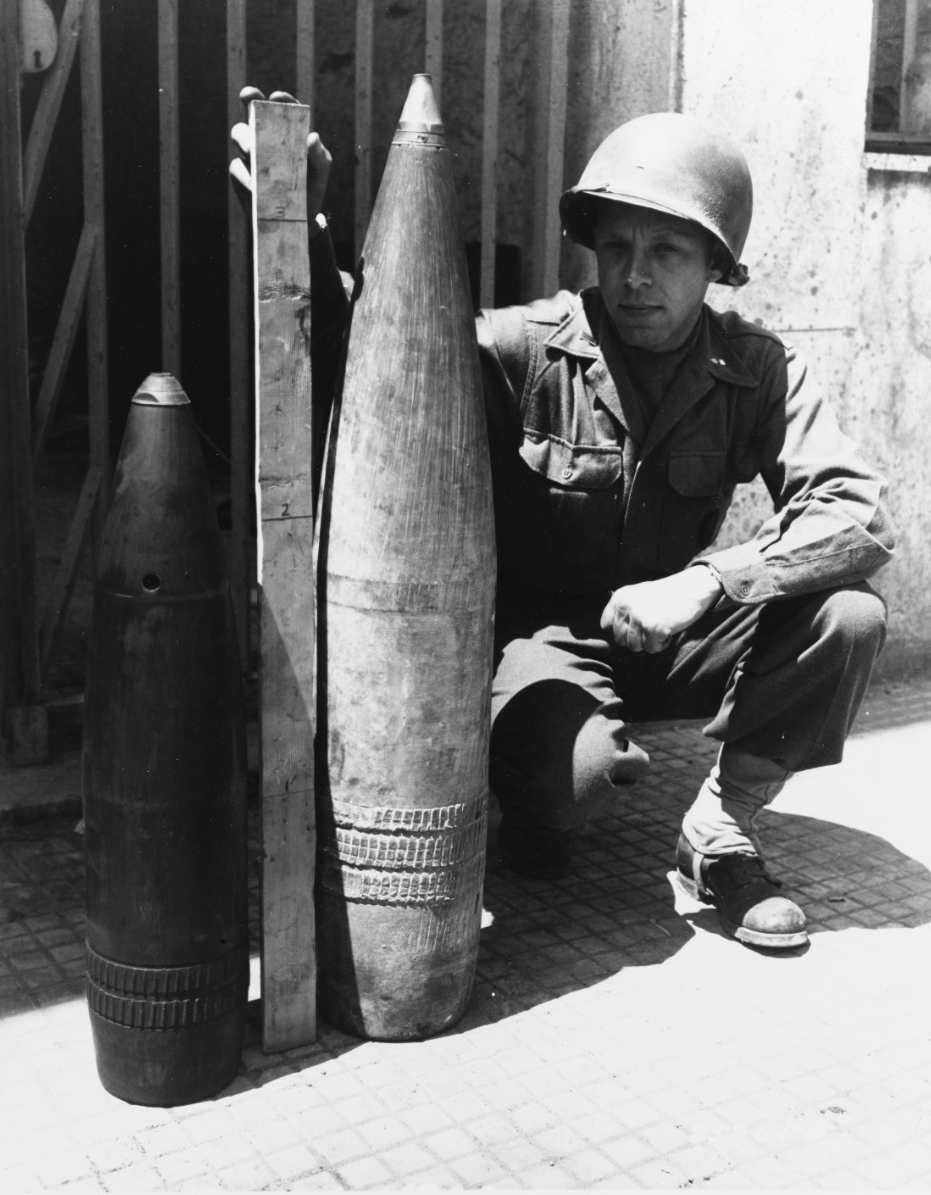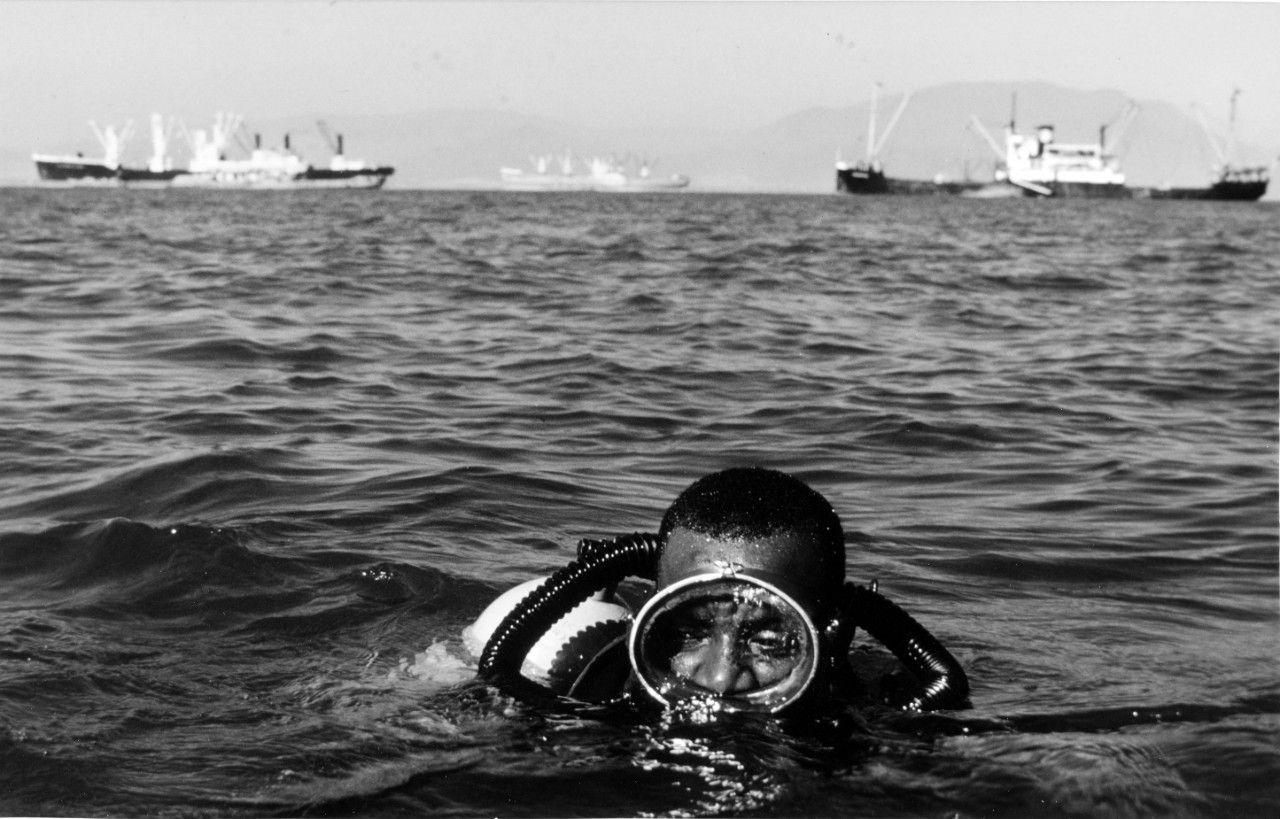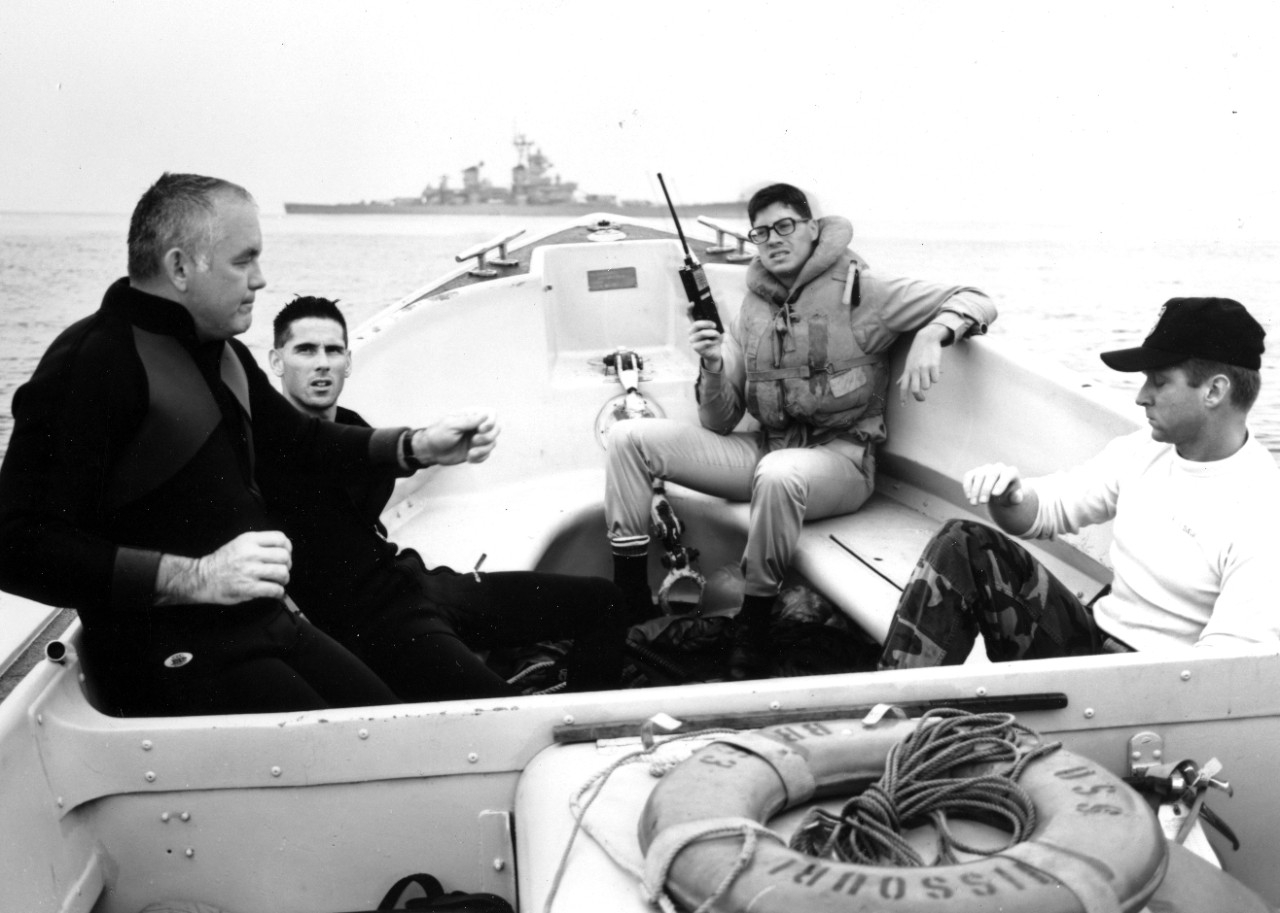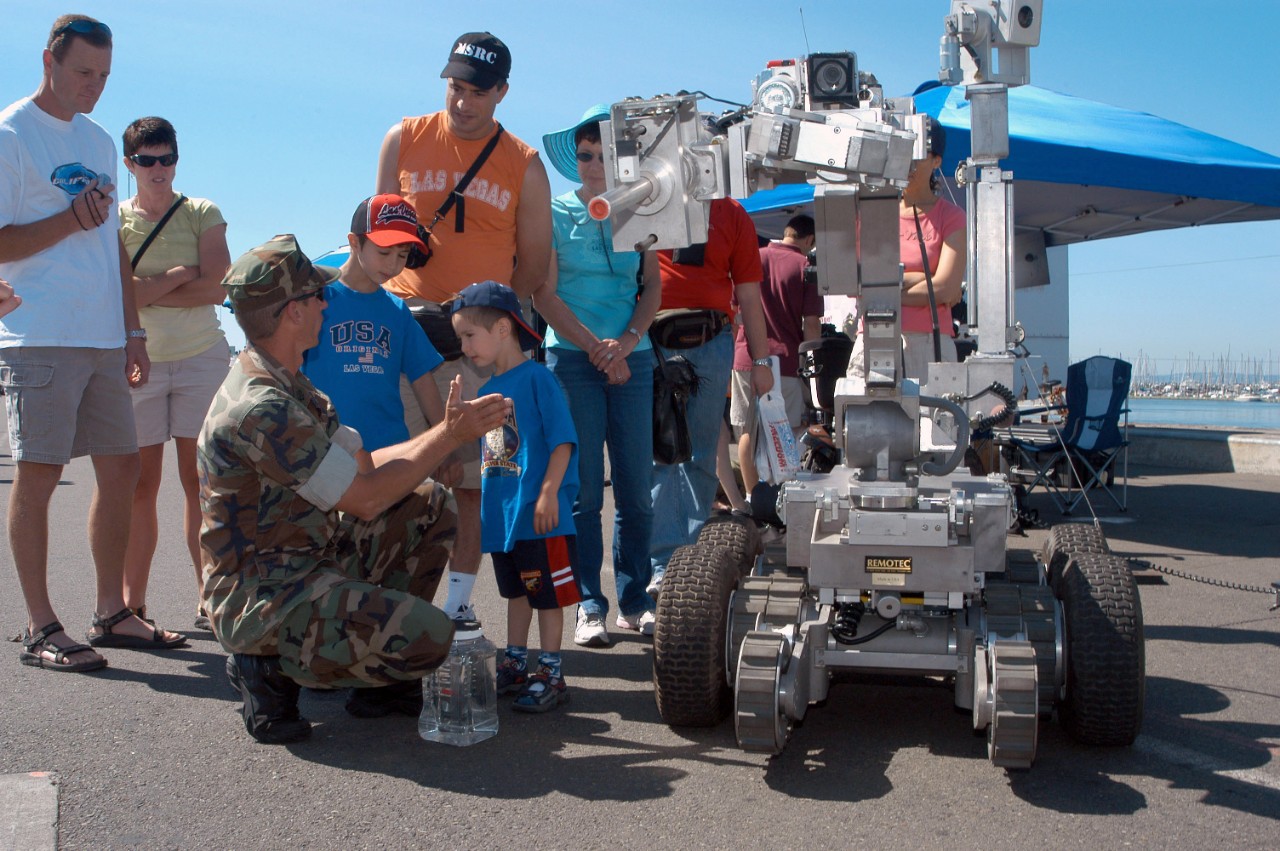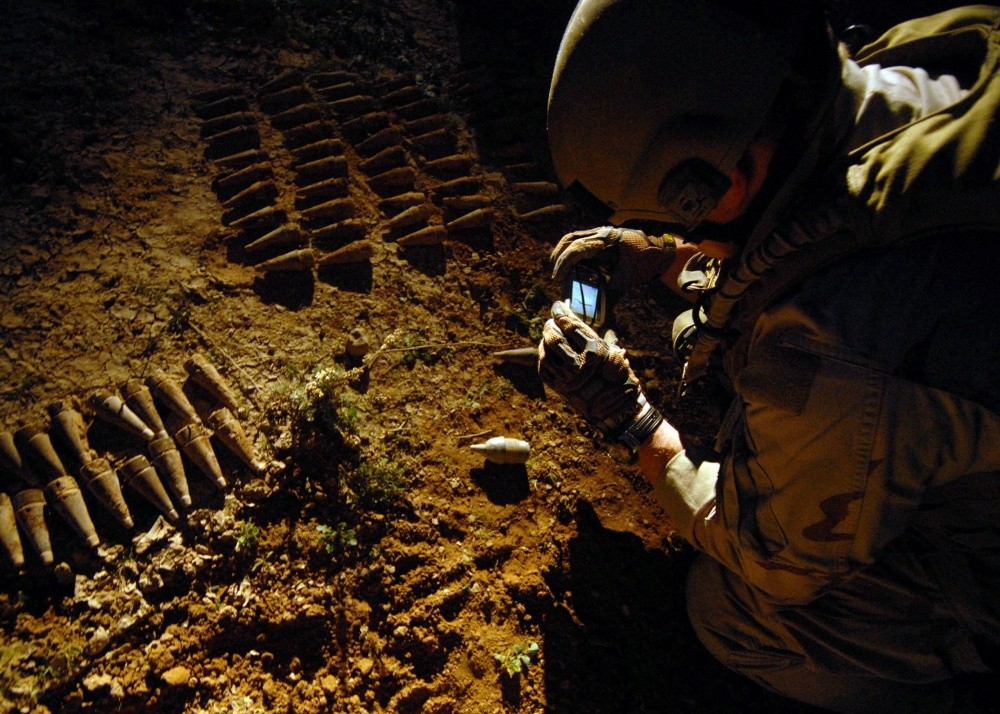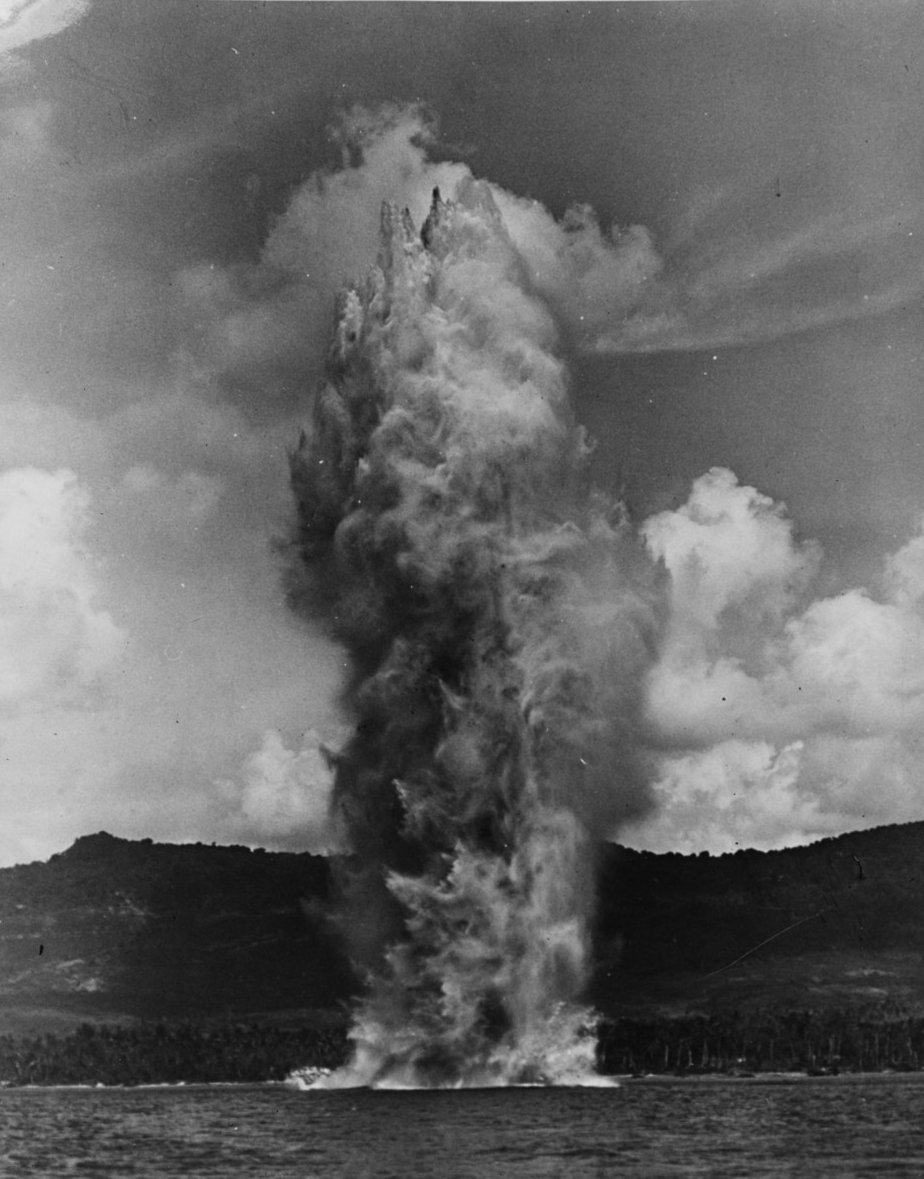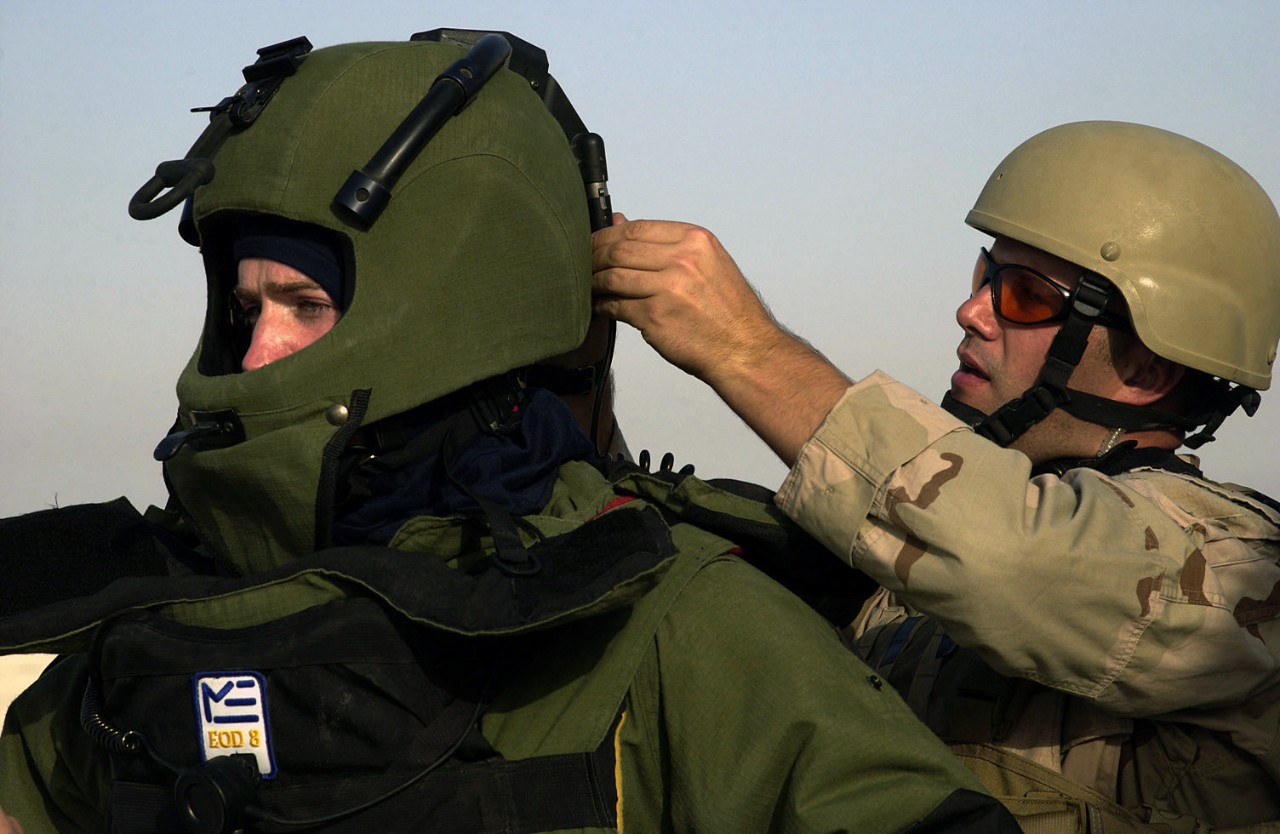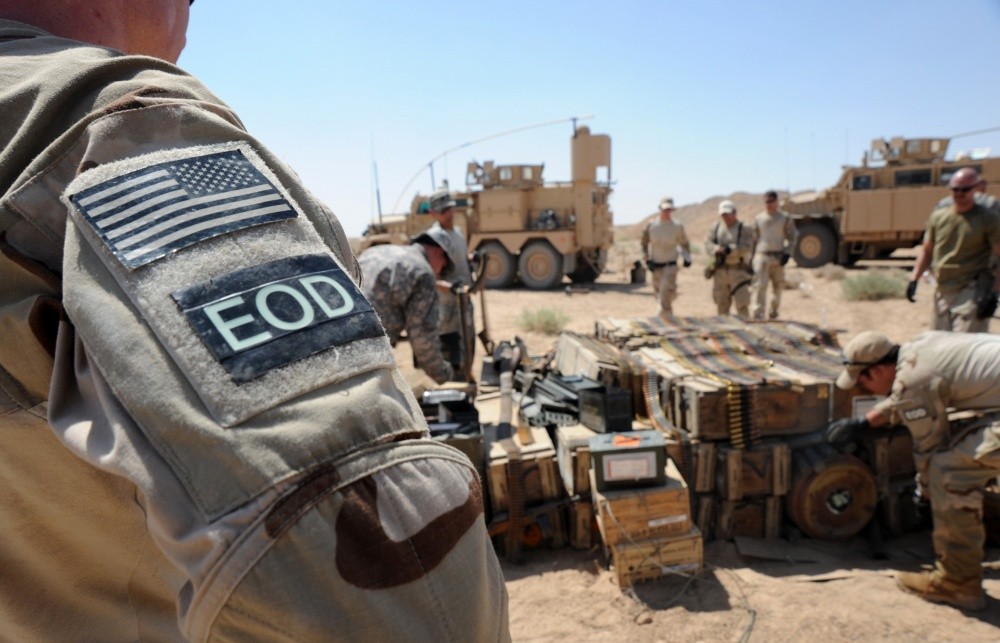Explosive Ordnance Disposal
Removing Iraqi Speed Bumps. A Navy EOD diver (Explosive Ordnance Disposal) and a Saudi navy counterpart, approach a live Iraqi mine in the Persian Gulf for retrieval and examination at the EOD unit at Jubayl, Saudi Arabia. Painting, acrylic on board; by Chip Beck; 1991; framed dimensions 29H X 35W. Accession #: 91-159-AC.
Prior to World War II, there were no formally trained bomb or mine disposal personnel, but the need became apparent when in 1939, the British navy dismantled the first German magnetic mine that had washed up on the shore of Shoeburyness, England. In 1941, the U.S. Naval Mine School was established at Naval Gun Factory in Washington, D.C., and subsequently, the Bomb Disposal School was established. The first U.S. casualty in mine disposal was in 1942, when Ensign John M. Howard was killed when he attempted to dismantle a booby-trapped German magnetic submarine-laid moored mine. About 20 trained bomb and mine disposal personnel, to include Howard, were killed in action during WWII.
In 1946, the U.S. mine and bomb schools combined at the Bellevue Annex at the Naval Gun Factory, and then moved to the Naval Powder Factory, in Indian Head, Maryland. The training curriculum was designated explosive ordnance disposal giving birth to the term “EOD.” The following year, the Bureau of Naval Weapons designated the first naval unit for “research, development, test, and evaluation of EOD equipment,” and would later become an integral part of the EOD School.
In 1953, two major operational EOD units were established. EOD Unit ONE supported operations in the Pacific and was homeported at Pearl Harbor, Hawaii. EOD Unit TWO supported operations in the Atlantic and was homeported at Charleston Naval Base, South Carolina. Today, EOD Unit ONE is headquartered at Naval Amphibious Base Coronado, California, and EOD Unit TWO makes Joint Expeditionary Base Little Creek-Fort Story, Virginia, its home. In 1999, the EOD school was also consolidated and moved to Eglin Air Force Base, Florida, where today it is a Joint EOD training facility. Elgin Air Force Base is the home of the EOD Memorial that honors EOD technicians who have given their lives in the performance of their duties.
In the aftermath of the terrorist attacks on September 11, 2001, EOD personnel deployed in support of the operations Enduring Freedom and Iraqi Freedom. The operations would prove to be extremely hazardous with the widespread use of improvised explosive devices and vehicle improvised explosive devices by insurgents and al-Qaeda operatives. More than 130 U.S. Air Force, Army, Navy, and Marine Corps EOD personnel lost their lives over the duration of the operations. The Navy lost more than 20 of its EOD technicians. Although the operations in Afghanistan and Iraq took a heavy toll on the EOD community, it is immeasurable how many lives they saved.
Today, Navy EOD is staffed with nearly 3,000 officers and enlisted personnel, who are the world’s premier force for maritime mine countermeasures, counter improvised explosive devices, weapons of mass destruction, and all other types of weaponry. Their mission is to provide naval special warfare and conventional forces access to areas laden with explosives. Navy EOD also play a vital role in the safety of servicemembers and civilians. Their bravery and technical skills ensure operational success.
*****
Suggested Reading
- Improvised Explosive Devices (IEDs) in Iraq: Effects and Countermeasures
- Navy Irregular Warfare and Counterterrorism Operations
- USS Chincoteague (AVP-24) Bomb Damage: Saboe Bay, Santa Cruz Islands
- Demolition Units of the Atlantic Theatre of Operations
- Joint Publication 3-42: Joint Explosive Disposal
- “EOD Up!”; How Explosive Ordnance Disposal Forces Can Best Support Special Operations Forces
- History of EOD
Blogs/Articles
- Navy Expeditionary Combat Command Pacific Established
- Naval School Explosive Ordnance Disposal
- True Grit: EOD Dive School
- Navy EOD: Clearing the Arctic’s Sea Lanes for our Fleet and Nation
- CENTCOM EOD Teams Link Up for Joint Service Field Training
- Sailor Continues Family’s Dive Legacy during YOMD Celebration
Selected Imagery
Lieutenant Richard J. Misel of the 149th Bomb Disposal Squad measures a German 210mm general-purpose high explosive shell that landed on the Anzio Beachhead. The dud shell is 42 inches tall and weighs 265 pounds. At left is a 170mm shell. Photographed May 13, 1944. National Archives photograph, SC 257650.
Italian “MTM” Explosive Motor Boat captured by USS Gleaves (DD-423) off San Remo, Italy, 2 October 1944. The boat at Isle St. Marguerite, France, where it was towed for further study of its explosive mechanisms, on 3 October 1944. Personnel on dock are from U.S. Navy Bomb Disposal Unit. Naval History and Heritage Command photograph, NH 77007.
Mineman Second Class Franklin Marshall, a Navy explosive ordnance disposal team member, conducts a search for mines, especially those attached to ship's hulls, circa April 1966. The EOD Team was responsible for harbor security. Several merchant ships are in the distance. Photographed by Ernie Filtz. Official U.S. Navy photograph now in the collections of the U.S. National Archives, K-31466.
U.S. Navy Explosive Ordnance Disposal Technician, Chief Petty Officer Matthew Broderson, assigned to Explosive Ordnance Disposal Mobile Unit 11, Detachment Northwest, Naval Air Station Whidbey Island, Washington, discussed the use of remote robotics in the field during a presentation at Seafair's Fleet Week, 5 August 2006. U.S. Navy photo by Mass Communication Specialist 1st Class Mary Popejoy. National Archives identifier 6699049.
Petty Officer 1st Class Ben Jones, explosive ordnance technician, assigned to Explosive Ordnance Disposal Mobile Unit 1, gathers intelligence by photographing an unidentified projectile fuse in Tikrit, Iraq, 12 May 2008. EODMU-1 was deployed at the time in support of Operation Iraqi Freedom. Photo by Petty Officer 2nd Class Joan Kretschmer.
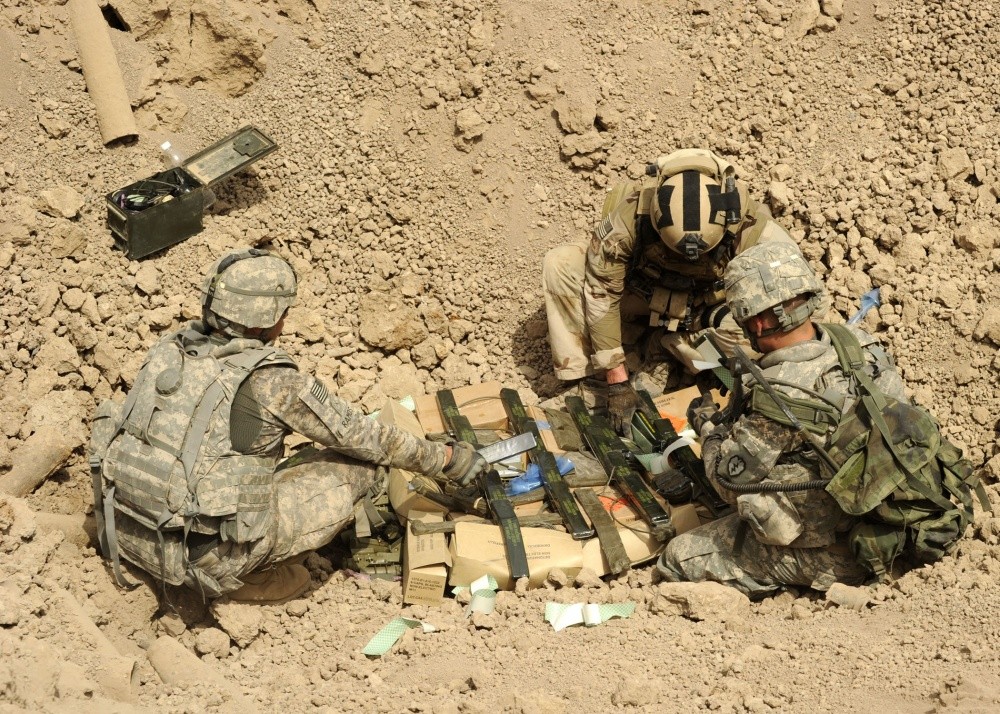
A U.S. Navy explosive ordinance disposal technician and two U.S. Soldiers with 66th Engineer Company, place weapons from a cache to be destroyed at the Iraqi demolition range in the Diyala province, Iraq, 29 July 2010. Navy EOD-l Mobile Unit Two, Company 2-2 and 5th Iraqi Army Bomb Disposal Company disposed of more than 1,100 pounds of ordinance seized by Iraqi and U.S. forces. Photo by Sergeant Brandon Bolick.
U.S. Navy Explosive Ordnance Disposal (EOD) Technicians Boilerman First Class Paul C. MC. Craw, (left) and Mineman Third Class Ralph E. Loux, examine a Viet Cong Claymore type mine, which was disarmed by a member of the six-man bomb squad assigned to U.S. Naval Support Activity, Saigon, Republic of Vietnam. The cutaway exposes the mine's missiles formed of iron construction rods shaped into a coil and notched to break into deadly pellets. Naval History and Heritage Command photograph, NH 73230.
U.S. Navy Hull Maintenance Technician Second Class Carl Harris (left) waited patiently as Chief Electronics Technician Ronald Olmsted assembled his EOD-8—explosive ordnance disposal suit—during a training session, 10 May 2005. Members of Explosive Ordnance Disposal Mobile Unit Four Detachment 12 conducted a final evaluation phase of training to simulate operations the team may experience while supporting maritime security operations. Photo by Photographer’s Mate 1 Aaron Ansarov. National Archives identifier 6655667.
U.S. Marine Corps Corporal Justin Lefan, center, from 1st Battalion, 23rd Marine Division, observed U.S. Navy Explosives Ordnance Disposal Specialist 2nd Class Corey Baughmann, left, measure timer fuse cords for Explosives Ordnance Disposal Specialist 2nd Class Christopher Blount before a demolition training during exercise “Natural Fire” at Nginyang, Kenya, 10 August 2006. U.S. Navy photo by Mass Communication Specialist 2nd Class Roger S. Duncan. National Archives identifier 6702189.


